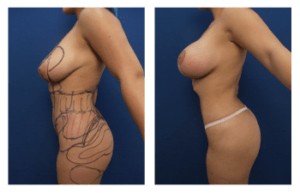

Buttock augmentation risks are dependent on the technique of augmentation chosen for the patient desiring buttock enhancement. Patients who possess minimal fat or those who desire accentuation of their buttock projection are recommended buttock augmentation using a buttock implant. The number one buttock augmentation risk using buttock implants is implant extrusion.
This is because the buttock is under a lot of physical compressions and shear force. When implants are chosen that are too large to fit completely within the gluteus major muscle, then extrusion becomes more common. This is, in fact, a very common problem with reports of one in five buttock implant extrusions occurring throughout the nation.
Factors Increasing Buttock Augmentation Risks
The reason for this high rate of complication is that patients are demanding to have implants that are larger than what can be accommodated by their gluteus muscle. It is imperative that buttock specialists accurately measure the buttocks dimensions and unequivocally prevent patients from choosing buttock implants that are too large for their gluteal muscle.
Accurate intramuscular dissection and selection of conservative buttock implant sizes that comfortably fit inside the muscle are critical to minimizing buttock augmentation risks. Another option for buttocks augmentation includes fat transfer, coined the Brazilian buttock lift, which can be performed in patients who possess adequate amounts of the fat reserve.
With the advent of ultrasound-assisted liposuction, patients’ are now taking advantage of improved ability to harvest fat for the purposes of fat transfer. In fact, Vaser liposuction is able to harvest on average 40 % more fat than traditional techniques thus allowing more patients to take advantage of using their own fat for buttocks augmentation.
The most feared complication of the Brazilian buttock lift remains a fat embolus which refers to the fact that fat cells being transplanted into the buttocks can get into the bloodstream and end up clogging vessels downstream.
If a fat globule ends up clogging vessels in the lungs, this is called a pulmonary embolus, and it can have a detrimental effect. Many preventive steps have been developed to avoid fat emboli including a recommendation by the American Society of Plastic Surgeons to avoid intramuscular buttock fat grafting of the gluteus major muscle.
With precaution and appropriate surgical design and implementation, buttock augmentation risks are typically avoided.
Please admire this 25-year-old female who has successfully undergone buttock augmentation with VASER high definition liposuction of the back, medial thigh, and lateral thighs and fat transfer to the buttocks.


